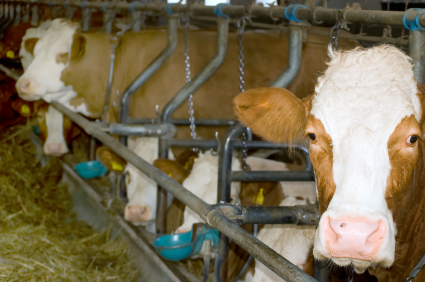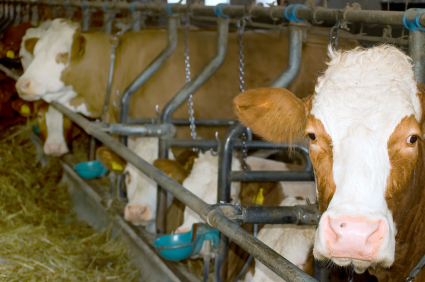 Washington Post food-politics columnist Ezra Klein has taken a stand: people should eat less meat, because of its vast greenhouse gas footprint. To make his case, Ezra cited the FAO’s landmark “Livestock’s Long Shadow” report, which found that global meat production is responsible for 18 percent of total greenhouse gas emissions.
Washington Post food-politics columnist Ezra Klein has taken a stand: people should eat less meat, because of its vast greenhouse gas footprint. To make his case, Ezra cited the FAO’s landmark “Livestock’s Long Shadow” report, which found that global meat production is responsible for 18 percent of total greenhouse gas emissions.
To be honest, when I read Ezra’s column, I thought, “yeah, and?” Of course we should eat less meat. But how far will individual choice take us? Shouldn’t we focus on forcing the meat industry to pay up for its massive externalities, including its contribution to climate change? Yet this eat-less-meat plea ended up generating more controversy than I thought possible.
In a letter to the editor published Monday, J. Patrick Boyle, president of the American Meat institute, fired back, declaring Klein’s take on meat “inaccurate and not scientifically based.” How so? According to Boyle:
The Environmental Protection Agency concluded that in 2007, only 2.8 percent of U.S. greenhouse gas emissions came from animal agriculture.
He concludes: “The animal protein sector in the United States is environmentally and socially responsible, and we strive to provide the safest, most abundant and most wholesome product to consumers domestically and worldwide.”
Oh, really?
Boyle is a veteran fighter for the big-meat cause. The AMI lobbies on behalf of meat packers like Tyson, Cargill, and Smithfield. According to his bio, Boyle has led AMI since 1990. He had prepped himself for a career as a top lobbyist the traditional way–by working for the agency he would later lobby. His bio declares:
From 1986-89, Boyle was administrator of the Agricultural Marketing Service (AMS) at the U.S. Department of Agriculture (USDA). At AMS, he oversaw such programs as federal meat grading and the national beef and pork checkoff programs. He was responsible for administering 37 federal statutes affecting food quality, safety, research and marketing of meat, poultry, milk, fruits, vegetables, cotton and tobacco.
Indeed, the AMI is a popular stop for those who swing through the revolving door between government jobs and plumb lobbying positions. Click around its staff page and you’ll find plenty of former USDA and Congressional-staff apparatchiks.
So what of Boyle’s claim that Klein way overstated the GHG footprint of U.S. meat–that meat, in fact, contributes just 2.8 percent of total U.S. GHG emissions as compared to the FAO’s global estimate of 18 percent?
First, it should be noted that Klein and Boyle are talking about different things: Klein used global numbers, while Boyle pointed to strictly U.S. numbers.
And as Ralph Loglisci of The Center for a Livable Future at Johns Hopkins University points out in a recent blog post, the U.S. number will certainly be lower than the global one, for the simple reason that the U.S. spews out so much more greenhouse gases from all sources than the rest of the world.
We’re the globe’s largest per-capita emitter of greenhouse gas (and a close second to China in overall emissions). Here, the meat industry exists alongside a 211 million-strong fleet of generally low-mileage cars (propped up by a low-functioning mass-transit system), a network of coal-fired power plants that supply half of our electricity, and a built environment characterized by low-density sprawl.
In short, comparing meat’s share of greenhouse gas emissions domestically and globally, the denominator–total emissions–is relatively much higher domestically. To use that truism to excuse the carbon footprint of the U.S. meat industry is ridiculous–a form of vulgar relativism. Just because they’re surrounded by an abundance of SUVs and coal-fired power plants doesn’t make our meat factories any more benign.
Next, it must be acknowledged that the FAO study Klein cites and Boyle’s EPA source were measuring different things. As Loglisci points out, the FAO sought to calculate meat’s total GHG footprint–not only methane from cows and nitrous oxide from manure, but also emissions related to growing and hauling feed grains and moving processed meat to market. The EPA numbers cited by Boyle, by contrast, measure only methane from livestock and nitrous oxide from manure. Emissions related to feed are accounted for elsewhere, as is carbon released in the process of ventilating massive confinement houses, and moving meat from production centers like North Carolina and Iowa to far-flung markets.
Perhaps most egregiously of all, Boyle’s cherry-picked stat thus wrongly absolves the meat industry from nitrous oxide emissions associated with growing corn–a massive source of greenhouse gas.
How massive? According to the National Corn Growers Association (PDF), 44 percent of U.S. corn becomes domestic animal feed, and another 10 percent ends up in feed rations as the ethanol byproduct distillers grains. That means more than half of U.S. corn–our nation’s largest farm crop–ends up on feedlots.
And farmers use more nitrogen fertilizer on corn than any other crop by a wide margin. Using data from the charts on this USDA page, I estimate corn sucks in about 44 percent of nitrogen fertilizer applied in U.S. agriculture. So based on its reliance on corn, U.S. feedlot agriculture is responsible for nearly a quarter of total U.S. nitrous oxide emissions. And Boyle’s number conveniently omits that.
The omission is not trivial. In the agriculture section (PDF) of its “Inventory of U.S. Greenhouse Gas Emissions, 1990-2007,” the EPA credits “agriculture soil management”–i.e., nitrous oxide from fertilizer application–with about half of ag-related GHG emissions. And guess what? The EPA may be seriously underestimating here. A 2007 study by the Dutch Nobel laureate Paul Crutzen, an atmospheric chemist, concluded (PDF) that the accepted estimates for how much nitrogen fertilizer ends up in the air as NO2 could be off by a factor of as much as five.
So if Boyle’s 2.8 percent figure is off the mark, what percentage of U.S. greenhouse gas emissions does actually stem from meat production? Loglisci of The Center for a Livable Future says it’s hard to pinpoint. “As far as I know, no one has crunched the numbers to determine a comparable GHG emissions number for U.S. livestock,” he writes.
Working with a Johns Hopkins researcher, Loglisci compiled some rough numbers and came out with an estimate of about 9 percent–half of the global FAO number cited by Klein, but three times the figure pushed by Boyle. “And in real numbers, not percentages, U.S. livestock production’s GHG contribution could still be the largest in the world,” Loglisci writes.
So, yes, Ezra Klein was right–there’s a strong case for eating less meat.


